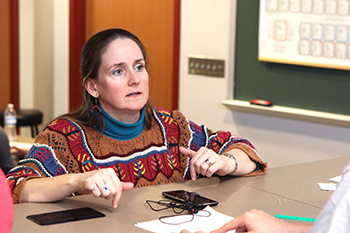Associate Professor and Chair of Psychology Karen Gunther was recently awarded a National Science Foundation (NSF) grant to examine how the human eye and brain perceive color.
The three-year, $200,749 grant will fund Gunther’s research project entitled, “RUI: Stimulus Characteristics Influencing Non-Cardinal Color Mechanisms.”
 “For over 200 years,” Gunther said, “it has been known that color vision begins with the three cone types in the retina. More recently, vision scientists have determined that the retina routes the cone signals into three “cardinal color” pathways: red vs. green, bluish vs. yellowish, and black vs. white.
“For over 200 years,” Gunther said, “it has been known that color vision begins with the three cone types in the retina. More recently, vision scientists have determined that the retina routes the cone signals into three “cardinal color” pathways: red vs. green, bluish vs. yellowish, and black vs. white.
“However, the manner in which light is turned into colored perceptions is not fully understood. In particular, how do people perceive colors beyond the six cardinal colors, the ‘non-cardinal’ colors?”
Using visual psychophysics, Gunther’s research will test how different spatial characteristics of stimuli (size, stripes, contrast) affect the ability to perceive non-cardinal colors.
In addition to the research itself, the grant will also fund upgraded lab equipment for Gunther, the second semester of her next sabbatical (2020-21), attendance at national vision science conferences, and two summer interns for the summers of 2018 and 2020.
“I enjoy working with students, and we usually have more student and faculty interest in summer internships than we have funding for,” Gunther said. “There is a great benefit in faculty-mentored research on student engagement and retention, and they will also help students get into graduate programs.
“If these students go on to get a PhD, they likely will spend their career doing research, so these internships will provide them with the experience graduate programs like to see. They will also help our students understand that we do not have eureka moments every day, but the process is worth it.”
Read more about the grant process and the reason behind Gunther's research here.